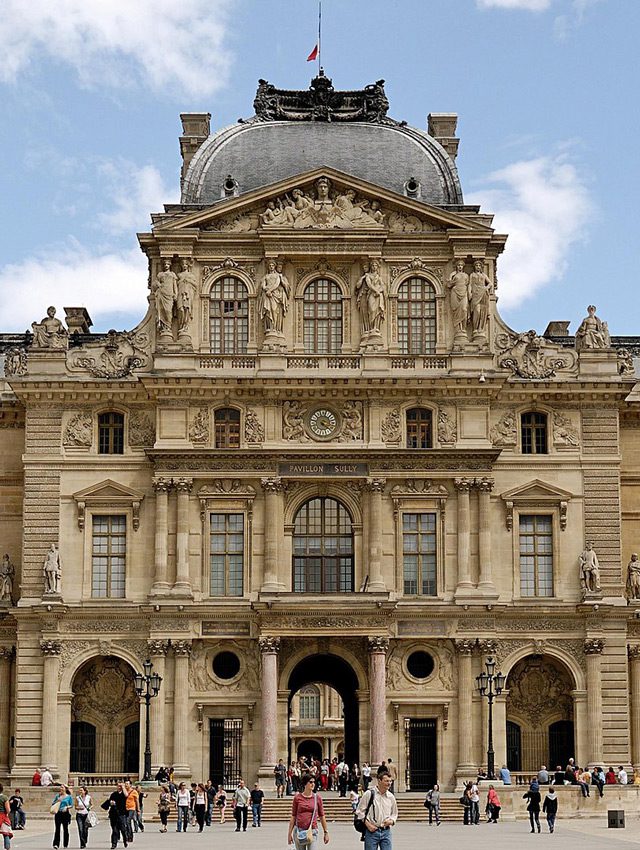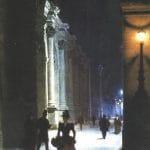
The Louvre stands as one of the most iconic landmarks in Paris, a symbol of art, history, and architectural brilliance. Renowned worldwide as the largest museum, it is also a testament to centuries of artistic and architectural evolution. Its story intertwines with the history of France, transitioning from a medieval fortress to a royal palace, and finally to its current status as a world-class museum. This architectural transformation reflects not just changes in artistic trends but also the shifting political and cultural priorities of France over the centuries.
The architectural journey of the Louvre mirrors the rise and fall of monarchies, revolutions, and the evolution of democracy in France. Its many phases—from medieval fortifications to Renaissance expansions and modern adaptations—demonstrate how the building has continually adapted to meet new needs and expectations. Each stage of its construction and transformation reflects a unique blend of styles, contributing to the Louvre’s status as a masterpiece of architectural innovation. This layered history is one of the reasons why the Louvre remains a subject of fascination for architects, historians, and art lovers alike.
The Louvre is not just a repository for art but an architectural landmark in its own right. It houses some of the most recognizable structures and elements of French architecture, blending Gothic, Renaissance, Baroque, and Modernist influences. This rich architectural diversity mirrors the museum’s diverse art collection, which spans ancient civilizations to contemporary works. Visitors are not only drawn to the treasures inside but also to the building itself, which has become a global symbol of artistic achievement and cultural heritage.
This article delves into the architectural evolution of the Louvre, from its origins as a fortress to its role as a museum. We will explore the contributions of renowned architects, the influence of historical movements, and the integration of modern designs. Together, these elements create a building that is both a masterpiece in itself and a home to countless others, showcasing the richness of French and global culture.
Origins of the Louvre: From Fortress to Palace
The Louvre’s origins date back to the late 12th century when King Philippe Auguste ordered its construction as a fortress to protect Paris from invaders. Built along the banks of the Seine, the structure featured thick stone walls, a large central tower, and a moat to fend off attacks. These defenses were necessary to safeguard the city, which was expanding rapidly and becoming an increasingly important center of trade and governance. The strategic location of the Louvre ensured it could monitor and control access along the river and surrounding areas.
By the 14th century, under King Charles V, the fortress began to transform into a royal residence. New residential quarters were added, and decorative elements softened its military appearance, signaling its growing role as a symbol of royal authority. These changes reflected the shift from a purely defensive structure to a space that could accommodate the French court. Lavish interiors and ornate facades began to replace the austere medieval features, setting the stage for the Louvre’s future as a palace.
The Renaissance brought profound changes to the Louvre under King Francis I, who sought to align France with the cultural developments sweeping through Italy. Inspired by Italian Renaissance ideals, he commissioned architect Pierre Lescot to redesign parts of the structure. Lescot introduced elegant proportions, ornate decorations, and large windows that flooded the interiors with light. His work, combined with sculptor Jean Goujon’s intricate reliefs, marked a departure from the Gothic style, establishing the Louvre as a reflection of the Renaissance spirit in France.
By the end of the 16th century, the Louvre had become more than a royal residence; it was a statement of power, sophistication, and artistic ambition. The structure symbolized France’s emerging cultural dominance and the monarchy’s desire to assert itself as a patron of the arts. Its transformation from fortress to palace demonstrated the growing importance of architecture in communicating political and cultural values. The groundwork laid during this period set the stage for future expansions and innovations.
The Grand Architectural Expansion of the Louvre
The 16th century saw one of the most significant expansions of the Louvre under the direction of architects Pierre Lescot and Jean Goujon. Lescot’s design of the Lescot Wing became a hallmark of French Renaissance architecture. This wing featured Corinthian columns, ornate sculptures, and intricate reliefs, exemplifying a harmonious blend of classical influences with French elegance. The interior spaces, including the King’s apartments, were equally grand, showcasing elaborate ceilings and detailed carvings that highlighted the craftsmanship of the era.
During the reign of Louis XIV in the 17th century, the Louvre underwent further transformations to reflect the grandeur of the Sun King’s ambitions. Architect Claude Perrault designed the eastern façade, known as the Colonnade, which became one of the most iconic elements of the Louvre. The Colonnade’s symmetry, classical proportions, and monumental columns introduced a sense of grandeur that epitomized the French Baroque style. Its design also reflected the influence of ancient Roman architecture, which was increasingly admired during this period.
The French Revolution in the late 18th century marked a turning point for the Louvre, as it transitioned from a royal palace to a public museum. This change necessitated significant structural adaptations to accommodate visitors and showcase France’s vast art collection. New galleries and spaces were created, highlighting the need for the Louvre to serve as both a cultural and architectural monument. The museum’s transformation during this time symbolized the democratization of art and the growing importance of cultural institutions.
The expansions and modifications during this era reflected France’s shifting political landscape. From monarchy to republic, the Louvre adapted, evolving into a building that embodied the values and aspirations of its time. This adaptability has been a hallmark of the Louvre’s history, allowing it to remain relevant and admired through centuries of change. The architectural innovations of this period laid the foundation for the museum’s continued growth and prominence.
Napoleon and the Louvre’s Imperial Architecture
Napoleon Bonaparte recognized the Louvre’s potential as a symbol of French imperial power and sought to elevate its status accordingly. During his reign, he undertook extensive architectural projects to enhance the museum’s grandeur and reinforce its connection to his empire. These projects not only expanded the physical structure but also solidified the Louvre’s role as a center of French art and identity, aligning it with his vision of France as a dominant cultural and political force.
One of Napoleon’s major contributions was the construction of the Cour Napoléon, an expansive courtyard surrounded by grand façades. The design drew inspiration from classical Roman and Greek architecture, reflecting Napoleon’s admiration for antiquity and his ambition to align his empire with these illustrious civilizations. The symmetry and scale of the courtyard made it a fitting setting for imperial ceremonies and public displays of power, further embedding the Louvre in the national consciousness.
Under Napoleon, the Louvre’s collection expanded dramatically, as artworks and treasures from across Europe were brought to Paris. This influx of art necessitated additional gallery space and prompted further architectural modifications. Napoleon’s architects worked to create cohesive spaces that could showcase these treasures in a manner befitting their importance. The resulting galleries not only displayed art but also contributed to the museum’s architectural identity.
Napoleon’s architectural vision for the Louvre was rooted in classical ideals but adapted to reflect the grandeur of his empire. The changes he initiated not only elevated the museum’s status but also ensured its place as a national treasure and an enduring symbol of French cultural dominance. His contributions to the Louvre remain evident today, as the structures and spaces created under his direction continue to shape the visitor experience.
The Louvre Pyramid: A Modern Architectural Marvel
In the 1980s, President François Mitterrand sought to modernize the Louvre while respecting its historical legacy. He commissioned Chinese-American architect I. M. Pei to design a new entrance. The result was the iconic glass pyramid, completed in 1989, which now serves as the museum’s main entrance. This bold addition marked a turning point in the Louvre’s architectural evolution, introducing a modern element that harmonized with its historic surroundings.
Pei’s pyramid was controversial when unveiled. Critics argued that its sleek, modern design clashed with the classical and Renaissance styles of the surrounding buildings. However, the pyramid’s geometric simplicity and transparency allowed it to harmonize with the historic architecture while providing a striking visual contrast. Over time, the pyramid has come to be seen as a triumph of modern design and a key part of the Louvre’s identity.
The pyramid is not merely a decorative addition; it is a functional masterpiece. Beneath it lies a spacious reception area that enhances the flow of visitors and improves accessibility. Its glass structure allows natural light to illuminate the underground spaces, creating a welcoming and modern environment. This integration of form and function exemplifies Pei’s architectural philosophy and highlights the pyramid’s role as both an aesthetic and practical feature.
Today, the Louvre Pyramid is celebrated as a bold architectural statement that bridges the gap between past and present. It has become a symbol of the museum itself, reflecting its ability to adapt and innovate while preserving its historical essence. The pyramid’s success demonstrates the power of architecture to unite seemingly disparate styles into a cohesive and inspiring whole.
Architectural Highlights Inside the Louvre
Inside the Louvre, architectural splendor continues to captivate visitors with spaces that showcase the building’s rich history and innovative design. One of the most famous areas is the Grande Galerie, a long, elegant hall adorned with high ceilings and large windows. The natural light streaming in highlights the masterpieces on display, creating an immersive environment for art appreciation. Originally conceived during the Renaissance, the gallery underwent numerous enhancements over the centuries, making it a centerpiece of the museum’s design.
The Cour Carrée, or Square Courtyard, is another architectural gem that reflects the Renaissance and Baroque influences that define much of the Louvre’s aesthetic. Surrounded by ornately decorated façades, the courtyard is a serene space where visitors can admire the intricate carvings and balanced proportions of the buildings. The symmetry of the Cour Carrée speaks to the meticulous planning that has characterized the Louvre’s expansions over time. It also serves as a reminder of the palace’s royal origins, offering a glimpse into the grandeur of the past.
The Napoléon Courtyard, which houses the iconic glass pyramid, represents the Louvre’s successful blending of historical and modern elements. This courtyard is not only a functional space for visitors but also a visual highlight that underscores the museum’s adaptability. The fountains and open spaces within the courtyard provide a striking contrast to the surrounding classical façades, creating a dialogue between tradition and innovation. This interaction between architectural styles makes the Napoléon Courtyard a microcosm of the Louvre’s overall evolution.
Throughout the museum, historical styles are seamlessly integrated with modern updates, creating a dynamic environment that enhances the visitor experience. Spaces such as the Richelieu and Denon wings, which were added during later expansions, reflect the same commitment to architectural excellence as the original structures. The Louvre’s interiors are as much a part of its allure as the art it houses, offering visitors an opportunity to appreciate the building as a living work of art.
Preservation and Restoration Efforts
Preserving the Louvre’s architectural integrity is an ongoing challenge that requires meticulous attention and substantial resources. The building’s age, combined with its immense size and heavy foot traffic, necessitates constant maintenance and restoration work. Each restoration effort must balance the need to maintain historical authenticity with the demands of modern functionality, ensuring that the Louvre remains accessible and relevant to contemporary audiences.
Over the centuries, several major restoration projects have been undertaken to preserve and enhance the Louvre’s historical elements. In the 19th century, architect Hector Lefuel played a significant role in restoring and extending the museum, particularly in the creation of the Richelieu Wing. His work preserved the Renaissance and Baroque elements of the building while introducing subtle updates that harmonized with the existing structures. Later projects in the 20th and 21st centuries focused on structural reinforcement and the integration of modern systems, such as climate control and improved lighting.
Balancing preservation with modernization is a delicate task. While efforts are made to maintain the building’s historical authenticity, upgrades are essential to meet contemporary needs, such as accessibility and sustainability. For instance, the addition of the glass pyramid addressed the growing number of visitors by creating a more efficient entry system without altering the historical façades. This careful approach ensures that the Louvre continues to function as a world-class museum while respecting its heritage.
Organizations like UNESCO have played a crucial role in safeguarding the Louvre’s status as a cultural and architectural icon. The museum’s designation as a World Heritage Site underscores its global importance and highlights the need for continued preservation. These efforts not only protect the Louvre’s architectural treasures but also ensure that future generations can experience its beauty and significance firsthand.
Conclusion: The Louvre as an Architectural Symbol
The Louvre’s architectural journey is a testament to its resilience and adaptability, embodying the history, culture, and artistic ambition of France. From its beginnings as a medieval fortress to its transformation into a Renaissance palace, a Baroque masterpiece, and a modern museum, the Louvre reflects the political and cultural shifts of its time. Its layered history is not merely a backdrop to its art collection but a vital part of its identity.
Each phase of the Louvre’s evolution has added to its richness, making it a living monument to the interplay of art, architecture, and history. The contributions of renowned architects such as Pierre Lescot, Claude Perrault, and I. M. Pei have ensured that the Louvre remains both timeless and innovative. The integration of styles and the bold addition of the glass pyramid demonstrate its ability to embrace change while honoring tradition.
As a symbol of French identity and a global hub for art and culture, the Louvre continues to inspire and captivate. Its architecture, like the art it houses, is a masterpiece that speaks to the creativity and ingenuity of humanity. Visiting the Louvre is not just an encounter with history but an invitation to experience the enduring power of great design.
Key Takeaways
- The Louvre began as a medieval fortress and evolved into a grand palace and museum.
- Renaissance, Baroque, and modern architectural styles are integral to its design.
- Renowned architects like Pierre Lescot, Claude Perrault, and I. M. Pei shaped its transformation.
- The Louvre Pyramid symbolizes its modern identity and innovation.
- Ongoing preservation ensures the Louvre remains an architectural treasure.
FAQs
- What was the original purpose of the Louvre? It began as a medieval fortress to protect Paris from invaders.
- Who designed the glass pyramid at the Louvre? The pyramid was designed by Chinese-American architect I. M. Pei.
- What styles influence the architecture of the Louvre? Gothic, Renaissance, Baroque, and Modernist styles all play significant roles.
- How has the Louvre’s function changed over time? It transitioned from a fortress to a royal palace, and then to a public museum.
- What is the significance of the Louvre’s location? It stands in the heart of Paris, symbolizing its cultural, historical, and artistic importance.




